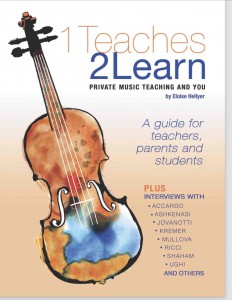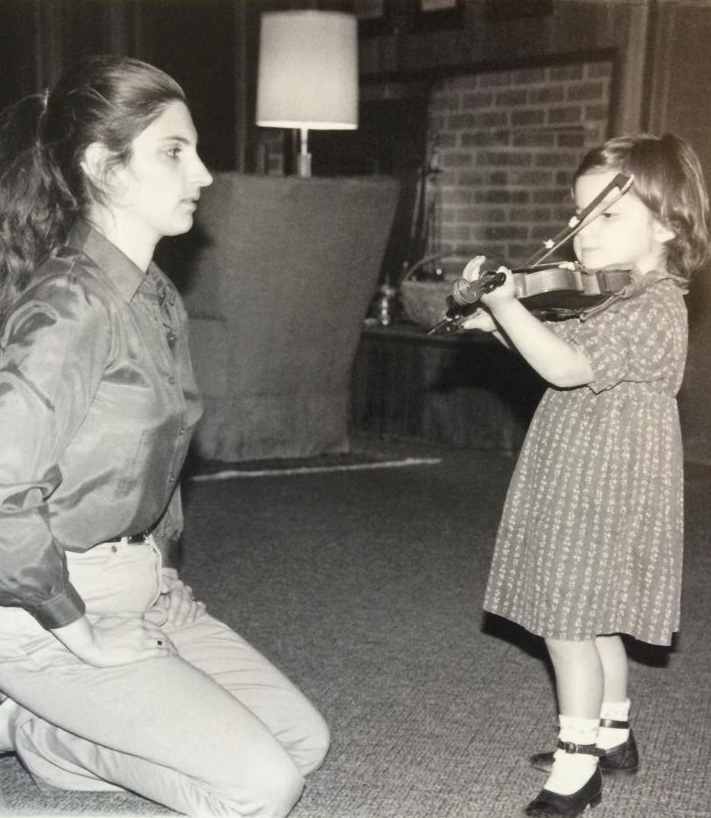Listening
“I have a high school student in Book 6 and need tips to get her to play in tune. I’ve tried everything: listening to her Suzuki cd, scales, double stops, etc. Help!”
Before trying any more technique, perhaps we should ask ourselves why indeed would any student be having such severe intonation problems. In this case, it isn’t poor teaching, as the teacher has used all the tried and proven methods. The answer also isn’t (except in extreme cases) a lack of a good ear or talent. Everyone learns to speak his or her own language, so in principle everyone has a good ear. But to be able to reproduce the appropriate sounds, you have to be able to listen first.
Children are born listeners. Don’t children learn to speak by listening? I have been teaching for over 40 years (including teaching my own children) and have noticed in the last few years that I am having more trouble than usual in getting students to play in tune. So what’s happening to their inborn listening skills? These students are all intelligent, well coordinated, have great parents, good ears, regularly put on their cds, etc., but getting them to listen to themselves, which is essential for intonation as well as everything else, is getting harder and harder. So lately, instead of concentrating on that or even concentrating on listening to music, I have found myself in the curious position of first having to teach students to listen to other people.
Why? I discovered that not only they aren’t listening to themselves (ergo out-of-tune notes they don’t correct), they aren’t truly listening to anyone else either—or even anything else. One student, for example, swears she listens to her cds yet she makes horrendous mistakes, which means she doesn’t hear the song in her head. Real listening, after all, involves a lot more than just having a CD on in the background.
What to do? Trying to figure out what could be the reason for this problem, I started asking students to repeat back simple requests or explanations I had made to them. This had never been a problem in the past. It is now. Most of them can’t do it the first time I ask. So I repeat it all again. Sometimes they get it, but often I have to repeat it even a third time to get the right answer. Hmm. I never ask anything difficult, so the problem must be more basic than just not listening to me. When I then ask students how many times their parents have to repeat something before they do as their parents ask or even answer them, there is general laughter all around as the student in question confesses shamefacedly and sotto voce, “Lots of times.”
Remembering our own childhoods, we may think, “What’s so unusual about that?” However, parents then tell me that their children’s school teachers complain about the same thing. This I find surprising. It seems to have become a general way of being: not listening to their teachers, to me, or to their parents, So how can we expect them to listen to themselves?
Therefore, I suggest to all of you whose students have intonation problems to find out what their other listening skills are like and try to improve those first. Listening for intonation in your own playing (not to mention tone, dynamics, etc.) is a very sophisticated skill, developed over years of quality listening. (Perfect pitch has nothing to do with it – if the student isn’t listening to himself, perfect pitch won’t help.) But listening, just like everything else, has to start at home.
So I give my students a very simple exercise: repeat every request their mothers make the first time they say it. Of course, the mothers (who are usually the ones who attend the lessons and who issue the most orders at home) are thrilled; so to even the playing field a bit, I add another caveat: mothers mustn’t talk too much. In other words, they must be careful to make make their words count. If they make a running stream of consciousness commentary on what their child should or should not be doing, their children aren’t going to listen to them— they simply turn off their ears, which becomes a habit that carries over into other activities. I also ask mothers to make sure that whatever they are asking their children to do is actually necessary and the comment they are making is absolutely essential so they don’t get on their children’s nerves. The students love this, of course.
It’s a little more fun with fathers. I have one who helps his daughter who also has listening problems. After I got the usual response from her of “lots of times” to my question about listening to her mother, her father then looked triumphantly at her with an “I-told-you-so” expression. I couldn’t resist it and asked him the same question: how many times did his wife have to ask him something before he answered? His face fell while his little girl’s lit up. I asked if he could he and his daughter couldn’t please set a good example for each other, and everyone laughed. Then, later in the lesson after reaching the usual agreement not to issue constant commands, he reproved his daughter, seconding something I had said (he’s new and not used to not speaking up). I stopped cold and asked him how he was raised. His answer was quite touching; he was raised exactly like that—constant corrections for stupid things which he said served for nothing and now that he realized it, he was going to reconsider his whole approach to dealing with his children. I complimented him on his honesty, open-mindedness, and intelligence; it took a lot of guts to admit to something like that in front of his child. And things are changing. Everyone is more relaxed and this student is getting much better at listening. So is the father, incidentally, although I haven’t double-checked this with his wife. :))
Then, having agreed all around on our listening exercise, I wait until the next lesson to see what happens.
Usually, it takes only one week of parental restraint and students repeating back what is said the first time, and we already start making progress on listening. All the parents have thanked me for this. There was one particularly hard case which took three weeks, but the difference in her intonation now is amazing as well as her level of concentration.
After this problem is more or less resolved (there can be some backsliding), I will occasionally ask students to repeat back to me what I say after I make a request or an explanation. Not often, but they know I might so they are more attentive. I have one flighty student who never stands still for a second. That hasn’t changed, but now she repeats back rather complicated instructions I give her. She is now listening, even though to an observer it may not look like it. Just because a child is fidgety doesn’t mean she isn’t listening. Just as the hard case I mentioned above stood perfectly still and seemed perfectly attentive, but wasn’t at all—until after those three weeks of my little exercise. Looks are often deceiving. Results aren’t.
At this point, I can turn to helping students listen to themselves. I put tapes on my beginners’ violins but it becomes very easy for them to become dependent on them: just slap that third finger down anywhere near the tape and all will go well. But good intonation, as we all know, depends on a lot more than a well-positioned tape or indeed on just the ear. There are certain things that have to be in place before a student will play in tune:
- The student has to hear every note he plays before he plays it. This is obvious to musicians, but students don’t know this. For many students (especially those who have tapes on their violins) it’s much easier to depend on the tapes than on their own ear. They usually play out of tune, hear it, and then decide if it’s worth fixing or not (usually they decide it isn’t and hope I don’t notice). Instead the problem has to be prevented, especially going from open E to third finger D on the A string. I stop students, tell them to hear the note clearly in their heads, and then put down the finger (with appropriate arm movement and on the correct side of the finger). The same thing before they start a song—listen to the open string and then hear the first finger in their heads, put first finger down, and so on, to get both the intonation and the correct hand position. This sounds laborious and it is. The only thing you can do to prove to your students that it works really well is play a very fast piece for them, tell them you heard every note in your head before you played it, that you weren’t born this way, and that that their ear and brains will get so fast that one day very soon they won’t even realize they are doing this. But you have to start somewhere.
- The student needs the correct hand (and finger) position and understand its importance. Or rather the correct hand position for his or her hand. This can be tricky. What works for us may not work for someone else. Without correct positioning of the hand (and elbow), the greatest ear in the world is worth nothing.
- The student has to care if he plays in tune or not. Many don’t—even though they say they do. It’s up to us to make sure they care. How? When they get a note in tune that they were having trouble with, tell them how happy they must be to get that note perfectly in tune. Doesn’t it feel great? They will usually reply that it does, even if they couldn’t care less. With time they will learn to care if you continue to call attention to how great they must be feeling when they do things properly.
Therefore, unless we address the issue of students not listening in general in their daily lives, we don’t have much hope of getting them to listen to themselves in their violin playing. I have been asking a few elementary school teachers if they have noticed this problem getting worse in recent years. Every single one of them has said that they have. Is the problem too many distractions, the frantic pace of modern life, too many video games, too much instant gratification on the Internet so that concentration is no longer necessary, too much stress at school? Perhaps, though doubtful in six-year-olds. Even if I knew the answer, all I can do as a teacher is address one student at a time, using that little but very efficacious exercise I mentioned above.
Teachers, get your students to listen attentively to their parents, then to you, then to hear in their heads the note in tune before they play it (I don’t find singing it particularly useful – they may sing and not listen or may not be able to sing in tune, but I will use it as a last resort), and the rest gets a lot easier. Parents learn a new way to be with their kids and students learn to pay attention to them. It’s then a small step to paying better attention to everything else, including themselves, their intonation, sound, and interpretation.
Post author: Eloise Hellyer
Share this:
Buy it on www.sharmusic.com - eBook format, avaliable worldwide, paperback in North America
COPYRIGHT
ABOUT
A music teacher’s thoughts and observations on the teaching and the study of a musical instrument, hoping to be of help to parents, students and teachers.
PHOTO
AWARDED TOP 25 VIOLIN BLOG
CATEGORIES
TAGS
ARCHIVES
-
Agosto 2022
Agosto 2023
Agosto 2024
April 2015
April 2016
April 2017
April 2019
April 2020
Aprile 2022
Aprile 2023
Aprile 2024
August 2014
August 2015
August 2016
August 2017
August 2018
August 2019
August 2021
December 2014
December 2015
December 2016
December 2017
December 2018
December 2019
December 2020
Dicembre 2022
Dicembre 2023
Dicembre 2024
Febbraio 2022
Febbraio 2023
Febbraio 2024
February 2015
February 2016
February 2018
February 2019
February 2020
February 2021
Gennaio 2022
Gennaio 2023
Gennaio 2024
Giugno 2022
Giugno 2022
Giugno 2023
Giugno 2024
January 2015
January 2016
January 2017
January 2018
January 2019
January 2020
July 2015
July 2017
July 2019
June 2016
June 2017
June 2018
June 2019
June 2020
June 2021
Luglio 2022
Luglio 2023
Luglio 2024
Maggio 2022
Maggio 2023
Maggio 2024
March 2015
March 2016
March 2017
March 2018
March 2019
March 2020
March 2021
Marzo 2022
Marzo 2023
Marzo 2024
May 2015
May 2016
May 2018
May 2019
May 2020
November 2014
November 2015
November 2016
November 2017
November 2018
November 2019
November 2021
Novembre 2022
Novembre 2023
Novembre 2024
October 2014
October 2015
October 2017
October 2018
October 2019
October 2020
October 2021
Ottobre 2022
Ottobre 2023
Ottobre 2024
September 2014
September 2015
September 2016
September 2018
September 2019
September 2020
September 2021
Settembre 2022
Settembre 2023
Settembre 2024
RECENT POSTS
Terry G and Me, or Terry Gilliam on Where (or What) Practicing the Piano Will Get You…
The Teaching We Don’t Do Is More Important Than We Think
Overwhelmingness or What Teaching and Motherhood* Have in Common
Cellphone Serenity
How to Build Your Reputation – the Kind You Want
Desperate Times, Desperate Measures. Or How to Deal With Your Strong-Willed Stubborn Student and Survive
“Why Does My Teacher Get So Frustrated?” Letter to a Perplexed Student
Mount Rush-no-more….And How to Get There
Realizzato con VelociBuilder - Another Project By: Marketing:Start! - Privacy Policy




